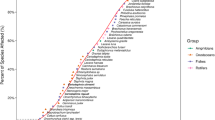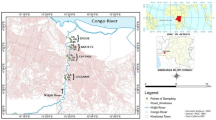Abstract.
The levels and patterns of organochlorines including DDTs, HCHs, and PCBs were investigated in sediments and tilapia (Tilapia mossambica) collected from inland water systems [Tai Wai (S1), Fo Tan (S2), Siu Lek Yuen (S3), Tai Po (S4), and Tai Wo (S5)] in the New Territories of Hong Kong. Sediment and tilapia samples were also collected from two fish ponds for comparison. The ranges of DDTs, HCHs, and PCBs in river sediments were 2.82–8.63 ng/g (DW), 0.05–2.07 ng/g (DW), and 43–461 ng/g (DW), respectively. All these values were significantly higher (p < 0.05) than the pond sediments. Low chlorinated congeners (especially mono-, tri-, and tetrachlorobiphenyls) were enriched in sediment samples accounting for 70–80% of total PCBs. The ranges of DDTs, HCHs, and PCBs in tilapia muscle collected from Fo Tan and Tai Wai were 28.2–40.1 ng/g (DW), 2.04–3.76 ng/g (DW) and 267–310 ng/g (DW), respectively. These values were also significantly higher (p < 0.05) than those collected from the fish ponds. Higher chlorinated PCBs (tetra-, penta-, hexa-, and heptachlorobiphenyls) were commonly found in tilapia accounting for almost 60% of the total PCBs. The effect of lipid contents in organochlorines accumulation was not significant (p < 0.05) in general.
Similar content being viewed by others
Author information
Authors and Affiliations
Additional information
Received: 24 July 1998/Accepted: 18 November 1998
Rights and permissions
About this article
Cite this article
Zhou, H., Cheung, R. & Wong, M. Residues of Organochlorines in Sediments and Tilapia Collected from Inland Water Systems of Hong Kong. Arch. Environ. Contam. Toxicol. 36, 424–431 (1999). https://doi.org/10.1007/PL00006615
Issue Date:
DOI: https://doi.org/10.1007/PL00006615




